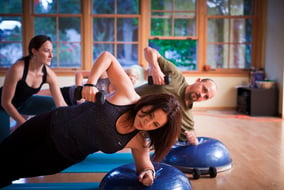When setting long-term fitness goals, it can be difficult to sustain our motivation. We often “run out of steam." So, why is it hard to sustain long-term fitness goals? How can we use a coaching approach to better support these types of goals?
Upholding long-term fitness and exercise goals can be powerful once they become a habit. Our bodies crave movement, so once we get in the rhythm of consistent exercise it can become liberating.
Once a habit forms, we seem to almost roll effortlessly into other healthy lifestyle changes. When thinking about fitness goals, here are some things to consider:
1. Get ready
Gauge your readiness to take the first few steps or any steps toward increasing your fitness health. Once you factor in, honestly, where you're at, you have the opportunity to decide what’s next and think about the steps it will take to get there.
Ask Yourself: What type of change are you ready for right now? Be honest with yourself: how much are you able to do (or not do)?
2. Troubleshoot
It’s important to contemplate resistance, possible barriers, and indecision in an open and honest way — this creates the opportunity for growth.
“You must expect great things of yourself before you can do them.” — Michael Jordan
Ask Yourself: Are you willing to be a beginner and ready to work to learn new skills? Willingness to trust in yourself creates confidence and resilience.
3. Determine your "why"
Connect to your goals by thinking through the reasons why this is an attainable fitness or exercise goal.
Ask Yourself: Why does this matter to you right now? Why is this important? What gets you fired up about setting and reaching this goal?
4. See the possibilities
We all know how powerfully visualization can evoke emotion and then belief. In the words of Mahatma Gandhi, “Your beliefs become your thoughts, your thoughts become your words, your words become your actions, your actions become your habits, your habits become your values, your values become your destiny."
Ask Yourself: What does it look and feel like to be your future self? Picture yourself there — what is that like?
5. Create SMART goals
Allow yourself to spell out your action steps. Once you've decided that you're ready, willing, and connected to your goals, you are pumped and prepared to act! Start by making sure your goals are SMART: specific, measurable, action-orientated, realistic, and time-oriented. This allows you to move from short-term action toward a long-term habit.
Next Steps: Check-in frequently and make sure to acknowledge your progress. Celebrate every success every step of the way. Keep planning it out (maybe even saying it out loud to others), envisioning and connecting to your goals.
Find support in groups, a coach, family, or friends. Have them help you change things up as your fitness routine becomes too routine. Remember the phrase "one in body, many in mind" — use other people's successes to keep you from getting stuck.
“Never let the fear of striking out get in your way.” — Babe Ruth
Spice up a maintainable fitness routine with even the smallest variable (maybe you try the class they’ve been afraid to try when you started). Bring yourself back to the theme of lifelong fitness and be willing to try something new.
6. Use mindfulness
Lastly, practice mindfulness. This is the Vera Whole Health Coach approach, and a powerful and dynamic tool you can use in many parts of your life.
The definition of mindfulness is “a mental state achieved by focusing one's awareness on the present moment, while calmly acknowledging and accepting one's feelings, thoughts, and bodily sensations, used as a therapeutic technique.” Consider health coaching, because a coach can help you bring awareness to the moment, whatever that may mean for you right now.
Ask Yourself: How does committing to your fitness bring about mindfulness and mindfulness bring about fitness?
With these 6 tools, you'll be much closer to building satisfying, sustainable habits that will keep you healthy throughout your life!
Sign up
Join our email list to receive the latest open positions, Vera Careers news, and more.




